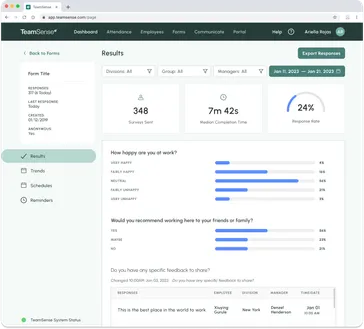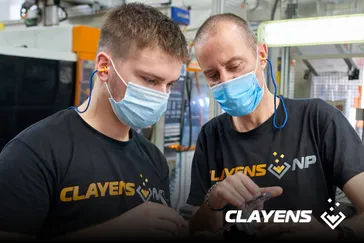When to HR with AI (and When Not To)!
Company
Clayens is a global manufacturer of polymer-based solutions, composites, and precision metals. The materials produced by Clayens are used to develop cutting-edge products in industries like healthcare, electrical infrastructure, automotive, and aerospace and defense. The company is headquartered in France with more than thirty plants in nine countries. In 2023, Clayens acquired Greenville, South Carolina-based Parkway Products (an existing TeamSense customer).
Challenge: The company was struggling with employee attendance and retention post-COVID.
Cassandra Cammons, Chief Human Resources Officer for the US division of Clayens (formerly Parkway Products), recalled a lot of employee attendance issues coming off the heels of COVID lockdowns.
“We came out of the pandemic to a completely different landscape. Things were pretty rocky. We were experiencing a lot of ‘no call, no shows’ and problems with turnover.”
Lack of communication around call-offs was the source of many of their problems. Newer employees didn’t know who to notify about calling off work and would either fail to notify the right person or accidentally leave voicemails for the CEO in an effort to reach their supervisor.
The lack of communication didn’t just end at call-offs.
“We had instances where people would leave the company without even telling anyone. They would just stop coming to work and we had no idea. We were completely in the dark,” Cammons told us.
Absenteeism and even unexpected attrition became detrimental to predictable operations.
She went on to explicitly connect absenteeism to productivity:
“[Reliable attendance] is the only way you know that the machines are running, because if the machines aren’t running, then you’re not making parts. If you’re not making parts, then you're not making money and you don't have a company.”
Solution: Overcoming reluctance to make phone calls with text messages
Cassandra set out to improve attendance and retention, starting with instituting an attendance policy and fixing call-off communication with TeamSense.
She recognized the value in TeamSense’s text-based call-off solution, stating
“People don’t like making phone calls now—especially when they’re sick or dealing with an emergency. With TeamSense, they can call off and share a reason for their absence with a few taps on their mobile phone.”
She attributes the strong partnership between HR and Operations as one of the key reasons for the successful TeamSense rollout.
“As soon as [the Operations team] saw TeamSense, they asked us how quickly we could get it implemented! They immediately saw how texting could help streamline the call-off process and more importantly, how it could reduce ‘no call, no shows.’”
Calling off via text also solved the problem of employees not knowing who to notify about absences. “They now have a line of communication with the company that they didn’t have before.”
After setting up the new call-off system, Cassandra soon realized TeamSense could be used for much more, like engaging employees via feedback surveys. They decided to launch surveys for new hire onboarding, company culture, and exit interviews using TeamSense Mobile Forms. According to Cassandra, these surveys helped the HR team at Clayens get better, more candid feedback than if they had been face-to-face with employees.
“We found out through the culture survey that the issues we thought we had were not the ones our employees were bringing up. TeamSense really helped us bridge the gap and truly understand what we needed to do next.”

Results: Better communication improved employee engagement
What started out as a way for employees to easily call-off became much more for Clayens. They realized several benefits for both attendance management and employee communication.
First, because TeamSense kept a timestamped record of every call-off, it removed ambiguity and minimized disputes between employees and HR.
“TeamSense is an impartial system. There’s no gray area or bias. The call-off is either recorded there or it’s not, so that’s helped us mitigate potential arguments.”
Second, being able to visualize attendance data directly in TeamSense’s dashboards eliminated a lot of guesswork for HR and allowed them to see behavioral trends that they previously hadn’t been able to see.
“The dashboards in TeamSense were a game changer for us in terms of really being able to understand what was going on with employee absences, as opposed to just guessing,” Cassandra said.
Finally, they were able to spin up new employee engagement programs that were successful right out of the gate. Because they used TeamSense to send surveys and get honest feedback, the HR team became much more attuned to what really mattered to their employees—and were able to build programs based on what the team actually wanted.
Next, they’re planning to expand and roll out TeamSense to other locations.


